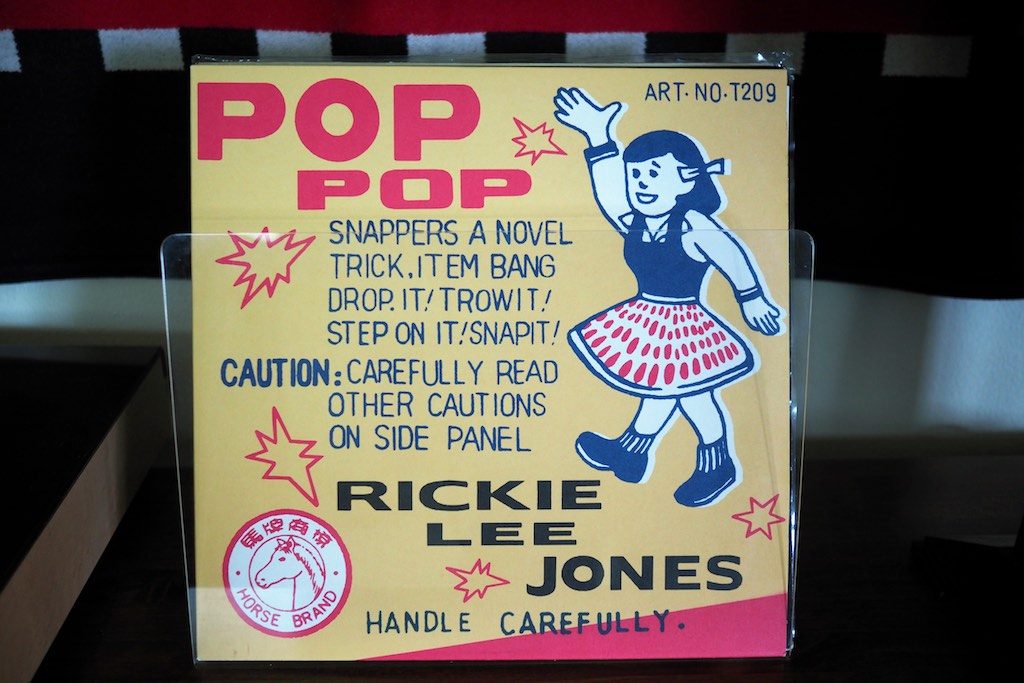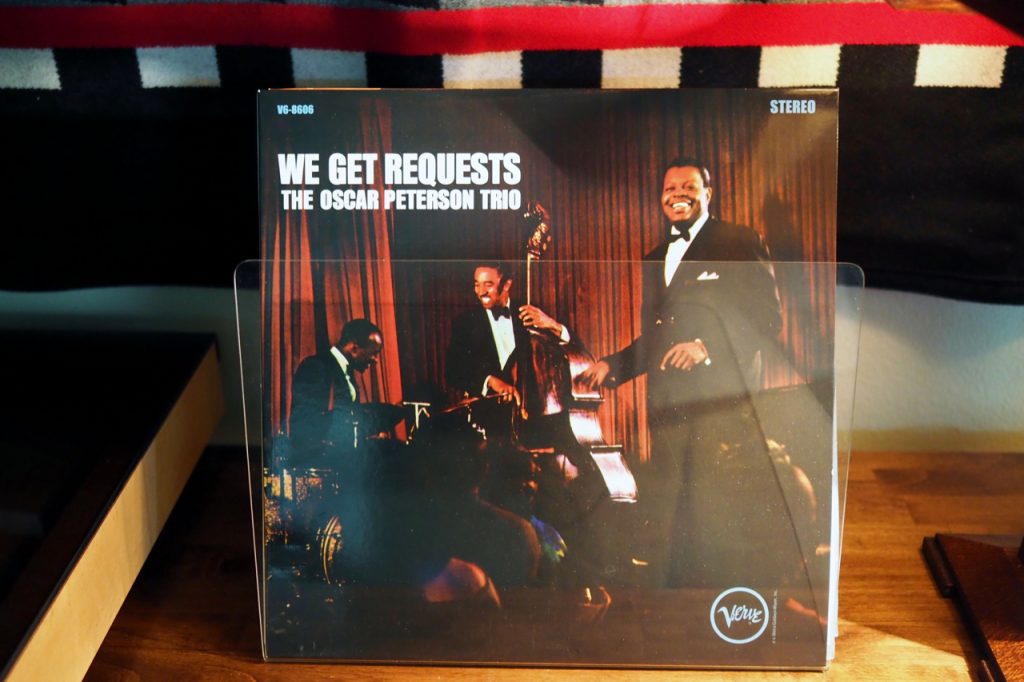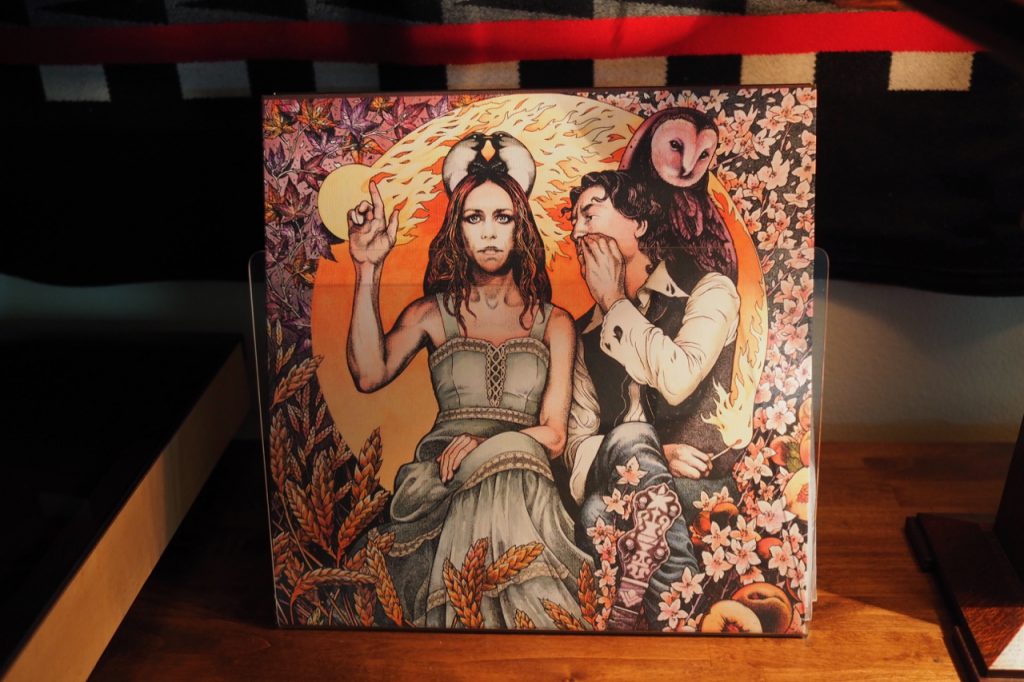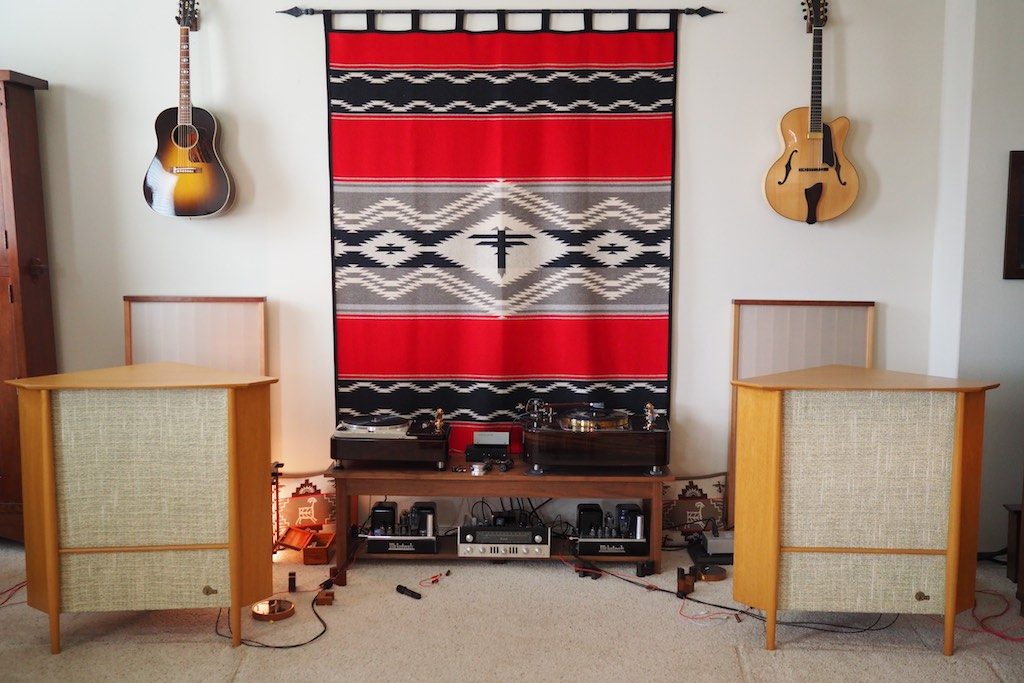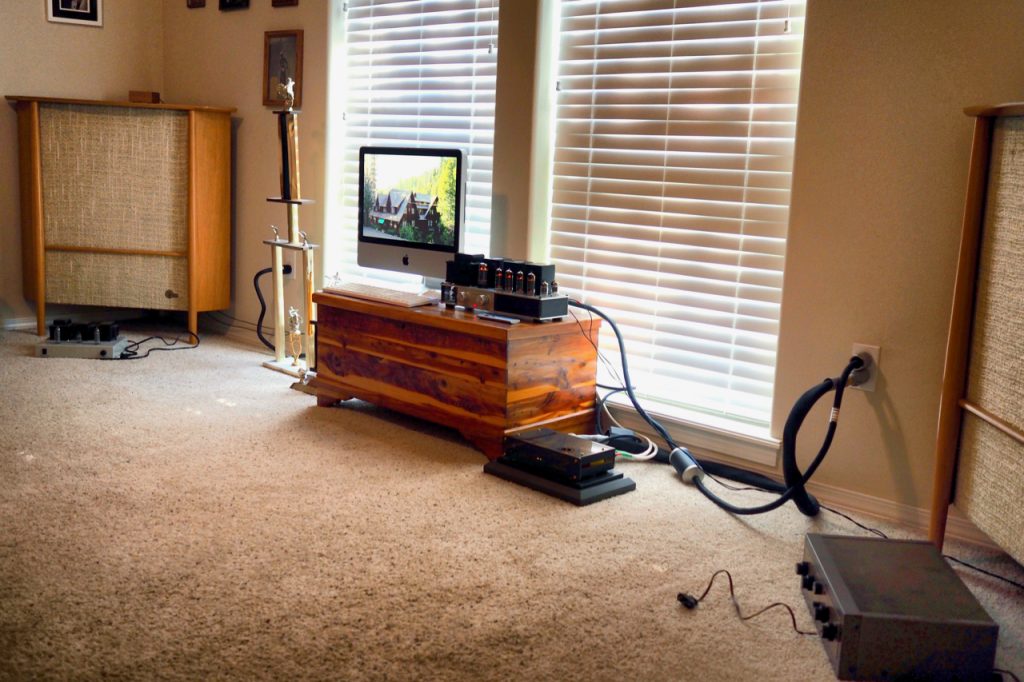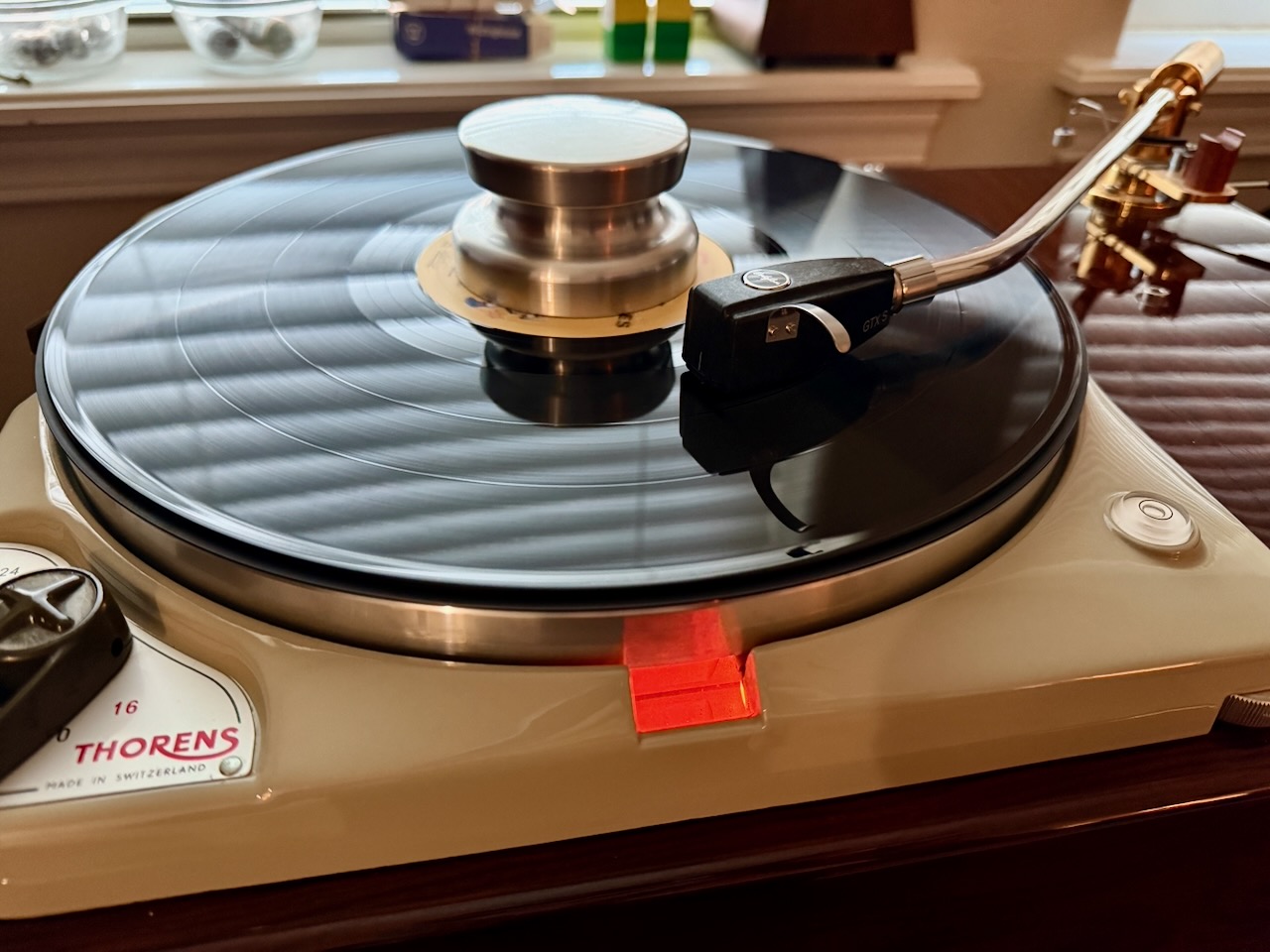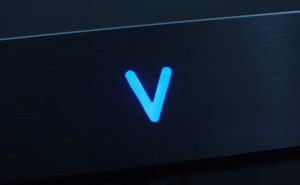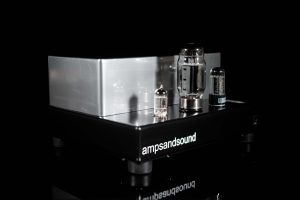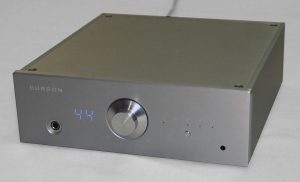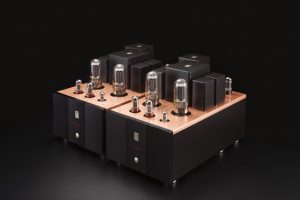Let's start with the 1978 acoustic jazz album by Egberto Gismonti that I just mentioned, Sol Do Meio Dia (ECM 1116, 2301 116), and I'll some listening impressions.
Egberto Gismonti (8-string guitar, bottle, kalimba, piano, vocals, and wood flutes), Naná Vasconcelos (berimbau, bottle, corpo, percussion, tama, and vocals), Ralph Towner (12-string guitar (tracks), Collin Walcott (bottle and tabla), and Jan Garbarek (soprano saxophone), weave a fascinating landscape of acoustic instruments into a rather remarkable tapestry of timbral textures, melodies, beats, and tempos.
My first impressions of listening to Sol Do Meio Dia were how resolved and spacious it sounded through the First Watt SIT-3. I could hear a lot of timbral nuance, a lot of dynamic nuance, a lot of space around the instruments, with overtones decaying naturally into it, and the music was all presented in a very tonally natural fashion, never sounding etched or forward at all.
The First Watt SIT-3 presented images vividly and with a real sense of solidity and tangible presence, with a wide soundstage, and with a lot of layering from front to back, and provided a room filling sense of spaciousness to the recording.
Sol Do Meio Dia is an album with so many interesting timbral and dynamic textures from unique instruments that it kept me riveted during late night listening, marveling at the interplay between musicians as they explored different combinations of strings, percussion, and vocals, in shifting melodies and beats, with complex harmonies that were beautiful, ethereal, and even haunting at times.
The First Watt SIT-3 proved to be resolving, articulate, and nuanced, with subtle gradations of timbral textures and dynamics in evidence, and provided a large sense of spaciousness, both in terms of the overall sense of acoustic space of the recording venue, but also with a very tangible reverberant acoustic space presented around each instrument being played.
I don't think I've ever heard an amplifier resolve that much musical & recorded nuance in such a natural fashion, and I was constantly hearing musical nuance I hadn't heard before in Sol Do Meio Dia (and other albums).
With the First Watt SIT-3 my first impressions on Sol Do Meio Dia were largely related to how it exceled sonically in reproducing recording artifacts like resolution, imaging, soundstaging, and the sense of recorded space, which can make listening quite mesmerizing from an audiophile-style sonics standpoint.
As I continued to listen I also found the SIT-3 to excel in tone, dynamics, and presence, which are three primary factors that makes recorded music feel live-like during home listening.
Tonally, the SIT-3 sounded very natural and seamless from the lowest frequencies up into the highest-frequencies. There was a superb timbral realism about the SIT-3 that I found very satisfying, with bass lines having as much realistically resolved timbral texture and nuance as instruments do in the midrange or high-frequencies.
Good vacuum tube amplifiers can also have superb timbral realism in the midrange on up into the high-frequencies, but I've not heard any vacuum tube amplifiers that can match the realism of timbral textures and nuance in the lower frequencies that the SIT-3 seems to do with such ease.
The SIT-3's dynamic performance was impressive as well, capturing the subtlest shifts in dynamics at pianissimo levels as it does at fortissimo levels, and everything in between, making crescendos and diminuendos come alive. This dynamic prowess also makes the beat in music very tangible and engaging, as well as breathing life into the subtler dynamics of melody lines, which gives a real sense of the musicians' nuance of "touch" upon their instruments and vocals, which greatly enhances the overall musicality of the presentation of the music.
The SIT-3 does a bit of a sonic magic trick when it comes to the very vivid yet natural sounding presence of the musicians and instruments upon the soundstage. The SIT-3 presents a huge sense of a living acoustic space associated with the recording venue, almost as if "space" was an instrument in itself contributing to the music.
In that overall acoustic space, I got a vivid sense of the acoustic space around each instrument (and a feel for how that instrument interacted with the surrounding space), much in the same way as the very best directly-heated single-ended-triodes can do, but in a more wholistic fashion that integrated the individual instrument acoustic space with the sense of space of the recording venue. I found the SIT-3 to present images with a lot of very natural sounding solidity, with that sort of intimate "they are here" illusion of the musicians being in the room with me.
One of the aspects of performance of the First Watt SIT-3 that I have found the most difficult to articulate adequately was its ability to open a window into the emotional content of the music, which it does in a number of different ways.
I thought the SIT-3 excelled in conveying the emotional "feel" the musicians were trying to convey with a particular song through their chordal choices, tempos, and dynamics, for example. The use of tone colors to set the emotional "texture" or mood through the use of various major, minor, sevenths, ninths, etc., chords, was very vivid and tangible, and the variation in beat, tempos, and dynamics that lend a sense of visceral motion, whether in urgency or relaxation, was rather unparalleled in my experience.
Also, the musicians' emotional state playing the music was clearly revealed to me during listening, and I could easily tell when they were really "feeling" it, whether it was with vocals infused with emotional nuance, or in the emotional intensity I felt occurring in the interchange between musicians when they were doing "call and response" and really getting into it.
I find it a little difficult to articulate the prowess of the First Watt SIT-3 to relay the overall emotional content and impact of the music, and the emotional interactions between the musicians in playing the music, because it is as much felt as heard.
With the SIT-3 I found it very easy to discern when musicians were emotionally "into" playing or singing, versus just playing music and singing in a serviceable manner.
While I understand some of the reasons why the First Watt SIT-3's performance conveyed such intense emotional impact from the music in the way it combined sonic prowess with superb musicality, but at other times I was just thinking, "How did it do that?".
With a superb album like the Analogue Productions 45RPM version of Rickie Lee Jones' It's Like This, I found the First Watt SIT-3 to be extremely good both musically and sonically, and from an emotional impact standpoint.
There's a huge cast of talented musicians on It's Like This, with Rickie Lee Jones, Carl Allen, Bruce Brody, Richard Davis, Jeff Dellisanti, Michael Elizondo, Peter Erskine, Ben Folds, Alex Foster, Conrad Herwig, Dan Hicks, Joe Jackson, Bashiri Johnson, Taj Mahal, Rick Marotta, Paul Nowinski, and John Pizzarelli, all adding in their own special kind of magic to the album (for details of who did what see the album link above).
It's Like This reminds me a little bit of Rickie's album of (mostly) old standards, Pop Pop, which I also like a lot.
It's Like This includes a set of superb songs written by Donald Fagen and Walter Becker (Show Biz Kids); Marvin Gaye (Trouble Man); Lennon and McCartney (For No One); Charlie Chaplin, Geoffrey Parsons, and John Turner (Smile); Jim Capaldi and Steve Winwood (Low Spark of High Heeled Boys); Lerner & Loewe (On the Street Where You Live); George Gershwin and Vernon Duke (I Can't Get Started); Hoagy Carmichael and Sidney Arodin (Up A Lazy River); George & Ira Gershwin (Someone To Watch Over Me); Gayle Caldwell (Cycles); and Leonard Bernstein and Stephen Sondheim (One Hand, One Heart).
There's not a single song on It's Like This that was penned by Rickie, but Rickie makes each song uniquely her own in a very satisfying way.
On "Show Biz Kids" I was impressed by the First Watt SIT-3's resolution of bass timbral textures and pitch, and the bass had a driving beat that gave a solid foundation to the music. Rickie's vocals were presented as rich, emotively nuanced, while having a smooth, breathy, and natural sounding sibilance, and Joe Jackson's backing harmony vocals came through distinctly. Percussion like triangles sparkled with natural sound, and I could hear the touch upon & timbral texture of the first impact—and "air" around—drum heads as they were struck, giving a very live-like feel to the music.
I also heard a nicely layered soundstage, being deep and layered, with images vividly but naturally presented across its depth and breadth.
I find it a little challenging to articulate how beautiful, nuanced, involving, and natural sounding the First Watt SIT-3 made my listening experience with It's Like This, and I've never heard it sound better in my Westminster Royal SE loudspeakers-based system.
The 2011 Analogue Productions 45RPM reissue (Analogue Productions AP-8606, Universal Music Special Markets B0015626-01) of The Oscar Peterson Trio's We Get Requests of the 1964 Verve Records (V6-8606) album is truly spectacular both musically and sonically.
With Oscar Peterson on piano, Ray Brown on bass, and Ed Thigpen on drums, this beautifully recorded and reissued album is rich with inspired musicianship, sparkling piano tone, and some of the best recording of a double bass and a jazz drum kit to ever appear on vinyl, and it truly puts an exclamation point on The Oscar Peterson Trio's last album for Verve.
One of the first things that struck me about "Quiet Nights Of Quiet Stars (Corcovado)" was the excellent resolution of timbral texture of Ray Brown bowing his bass, then his transition to fingerstyle bass playing, and then back to bowing. The First Watt SIT-3's lower-frequency resolution of timbre and pitch was really superb, and giving a clear articulation of Ray's fingering on the strings - there's no "one note" bass here that like I've heard from some tube amplifiers at times.
The First Watt SIT-3 displays in spades what I've come to think of as "relaxed transparency" where I heard a lot of resolution, like with Ray's bass lines, or the rather impressive amount of subtle recovered nuance from Ed's cymbals or the time keeping with his bass drum, but it was displayed so naturally and realistically that it really added a live-like feel of musicians "being there" in my living room.
Oscar Peterson's sublime piano playing displays artfully improvised melody lines perfectly synced with Ed's drumming, an ability I greatly admire, but the First Watt SIT-3 really helped me appreciate and gain insight into Oscar's impressive chordal playing, both in chord melody and chord rhythm styles, in this album and others.
The First Watt SIT-3's relaxed transparency, natural tonality, timbral realism, and superb resolution of dynamic gradations really opened up insights into Oscar's, Ray's, and Ed's technique in a way that really made me pause and consider what I had just heard, with a "Wow!" followed by a "How did it do that?" reaction.
That was a reaction that occurred often for me with well recorded and produced albums, like the Analogue Production 45RPM reissues, for example, that had me reaching for more of them in my record collection so I could hear with such musical clarity as heretofore unheard musical techniques in albums were revealed before my ears in ways that gave me even greater appreciation and respect for the incredible talent of the artists playing music.
I'm finding it a little bit difficult to articulate what it is exactly about the First Watt SIT-3's performance that allows it to give those sorts musical insights into technique so easily, but I'll share with you some of my musings on the topic.
The first thing that comes to mind is the SIT-3's ability to relay even the subtlest dynamic gradations from the lower frequencies all the way up into the high-frequencies. This performance attribute makes melodies and beat particularly articulate and interesting as nuances in technique became more evident, and it allowed tempos (or changes to tempos) to more fully express their emotive enhancement of the music.
Also, as I mentioned earlier, there's a sort of relaxed sort of high-resolution and transparency that allowed me to hear all kinds of nuance in the resolution of tone colors, timbral textures, the decay of harmonics over time, which gave a certain sense of naturalness and luxuriousness as instruments interacted with their acoustic space, and ultimately made for a very natural and live-like "in the room with you" portrayal of the musicians.
One of the albums that has been getting a lot of spin time on my turntables of late is Gillian Welch's and David Rawlings' The Harrow & The Harvest (Acony Records ACNY-1109LP). I really love the cool vintage-instrument musical-vibe Gillian and David get with their 1956 Gibson J-50 guitar, 1925 Vega Whyte Laydie banjo, 1935 Epiphone Olympic archtop, etc., with both Gillian and David contributing vocals, guitar, banjo, and harmonica playing, and with Gillian sprinkling in a little hands & feet percussion as well.
I recommend you check out Michael Fremer's excellent review of The Harrow & The Harvest HERE for some fascinating additional insights into Gillian's and David's superb musicianship and devotion to recording quality.
The First Watt SIT-3 is spectacularly musical on this beautifully recorded and produced album, with Gillian's and David's harmonies so tight you might think Gillian was singing solo if not for the SIT-3's subtle and nuanced unravelling of their harmonies.
One thing I find particularly intriguing and endearing about Gillian's and David's music, is that while their music is oft' described as a blend of Americana, bluegrass, folk, country, old-time, and roots music, I am particularly drawn to the haunting beauty that their jazz voicings add to the music. Their background as graduates of the Berklee School of Music (known for educating students in jazz originally, as well as a variety of historic and contemporary styles more recently), is abundantly apparent with their complex and artful incorporation of jazz voicings into their music, which elevates its emotional content & impact to another level.
Listen to David's crosspicking, for example, which evokes images of early country or bluegrass styles, but with David's unique jazzy voicings and tempos that are accentuated by his choice of playing vintage archtop guitars, David could be right at home in a jazz session.
Gillian and David have a knack for dark & jazzy Americana-like ballads that get across the vibe of the rural America that I grew up in as a youngster, with all its dark beauty, bipolar religiosity intertwined with provincial social issues, and a brooding hopelessness that seems to linger just under the surface these days due to the all too frequent poverty, drug abuse, and alcoholism.
The First Watt SIT-3 was spectacularly beautiful and musical on The Harrow & The Harvest in ways you just have to hear to completely understand the intensity of feelings it is capable of stimulating, with nuances of emotion and mood, tone color, harmonies, and melodies, that at times simply defied description of their effect on me as a listener.
Listening Impressions with Vintage Altec 832A Corona Loudspeakers
I love vintage Altec loudspeakers, they're just fun to listen to music with, and for those who are into low-powered amplification like DH-SET or First Watt amplifiers, they are so easy to drive to realistic live-like volumes that they make for a great pairing.
I bought a pair of mint condition vintage Altec 832A Corona domestic loudspeakers from LA Jazz Audio recently, shown in their brief stay in my living room in the photo above. After listening to them freestanding in my living room system (where they sounded promising), I moved them into their intended new home of my bedroom system, where they truly excelled when placed into the room corners with their room-corner shaped cabinets. Yeah, yeah, I know, that's one crazy big pair of loudspeakers for a bedroom system!
At the distance I can photograph them from, the room is too wide at 14 feet and 8 inches between corners to get both Corona's gracefully into a single photo, so hopefully the two accompanying photos will give you a better idea of speaker placement in the system.
I'm still in the process of building a system around the Corona's, as I need a nice wood rack that matches their Glen of California cabinets to place equipment on, as well as a few odds & ends to get everything sorted out as a system, but let me say that these vintage Altec 832A loudspeakers are some of the most enjoyable loudspeakers to listen to music with that I've encountered.
While decidedly more to the music-lovers than the audiophile end of the musicality spectrum, the Corona's are big, rich, and spacious sounding, and they easily fill my room with beautifully emotive music with even very low-powered amplifiers like my 5-watt singled-ended-pentode (SEP) Almarro A205A EL84 integrated amplifier, which has power to spare on the Corona's.
I haven't been able to find a sensitivity rating specifically for the Altec 832A Corona loudspeakers given the scarcity of vintage literature for them, but I suspect it would be similar to the 97dB sensitivity I have seen for the Altec 846B Valencia loudspeakers in vintage promotional literature.
You would think on the basis of their sensitivity rating alone that the Corona's would be more difficult to drive than the 99dB sensitive Westminster's, but that's not the case, and the Westminster's need a lot more power to drive than the Altec 832A Corona loudspeakers do.
Unlike with the more power-needy Westminster's, the First Watt SIT-3's 10 watts into the 16 Ohms of the Corona's was massively powerful, enough to power them to louder levels than I'll ever listen to them at on any dynamic peaks, and this is exactly the kind of loudspeaker context that the First Watt SIT-3 truly excels in.
Currently my vintage Altec 832A Corona loudspeakers (803A bass drivers, 802D compression drivers, 811B HF horns, N800E crossovers, and Glenn of California cabinets) based audio system utilizes Duelund DCA16GA tinned-copper wire as speaker cables, and I've added a pair of Spec RSP-AZ9EX Real Sound Processors (impedance compensators, connected with Western Electric WE16GA wire to the Corona's binding posts) that were made for me by Yazaki-san to complement the 16 Ohm impedance of the Corona's. Thank you Yazaki-san, you and the Spec RSP-AZ9EX's are awesome!
Normally my amplifier for this system is the SEP Almarro A205A EL84 integrated amplifier, but lately the Still Audio EL84 integrated amplifier that is in for review has been taking its place to get some run-in time.
Shielded Duelund DCA16GA interconnects connect the amp to an Mhdt Laboratory Paradisea+ USB DAC, which is powered by a Sablon Audio Gran Corona power cable, and connected by a Locus Design Group Polestar USB cable to my Apple iMac computer, which is what I'm currently using as a source, primarily to stream the superb Jazz24 radio station.






